Incoming UNLV USPS Mail
- The entire university is one mailing address.
- Individual departments are identified by a “Mail Code” which is required in the address of the mail piece to identify the final destination.
- The Mail Code for your area is determined by the UNLV Mail Center.
- All campus mail destinations are identified by the box number “45” plus 4 digit Mail Code. For example: Box 451045 = UNLV Mail Center.
- The Mail Code is also helpful when displayed as the suffix to the zip code 89154-XXXX.
- The inbound label should reflect the following example:
First and Last name John Doe Department Mail Center Box 45XXXX Box 451045 Street Address 4505 S. Maryland Pkwy City, State and Zip-XXXX Las Vegas, NV 89154-1045
- The USPS delivers incoming mail to UNLV at approximately 7 a.m. All properly addressed mail identified by a mail code is processed and ready for the same day delivery to departments beginning at 10 a.m. via established routes.
- The UNLV Mail Center handles all insufficiently addressed mail in accordance with USPS policies:
- An improperly addressed mail piece requires research to identify the destination department, which can delay delivery of the mail piece for several business days.
- Upon resolution, the addressee is requested to notify the sender of corrected address, to avoid future delays.
- First Class Mail that is improperly addressed where a Mail Code cannot be identified will be returned to the sender.
- Insufficiently addressed standard and bulk mail without an endorsement will be recycled in accordance with USPS policies.
- The Mail Center should be notified as soon as possible of any needed creation of (or changes to) a mail code or employee status (resulting from hiring, office moves, reorganizations, reassignments, etc).
- Business Reply Mail is received daily. It is sorted according to department’s name on the mail piece and then charged back to the department on a monthly basis. The pieces will be bundled and returned to the department. There is normally a 24-hour turnaround from the receipt of BRM mail pieces by Mail Center to department delivery.
- BRM service enables mailers to receive First-Class mail by paying postage only on the mail which is returned. All business reply postage and handling charges are billed back to initiating departments. UNLV BRM guarantees payment to the US Postal Service of the appropriate First-Class postage plus a handling charge per piece.
- The correct format of a Business Reply envelope is shown below. The piece must conform to a specific format to qualify as BRM, including a unique ZIP+4 code assigned by the USPS.
- To design any Business Reply envelope or card, consult with the university Mail Center for proper format; be sure to have proofs approved before printing (or let the Mail Center design these for you).
- A special format is required for Business Reply mail for foreign countries. Contact the Mail Center for further information.
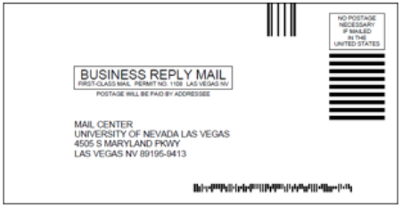
Outgoing UNLV USPS Mail
- Official university mail is processed with appropriate postage by the UNLV Mail Center. Outgoing mail is delivered once daily (Monday through Friday, holidays excluded) to the Sunset Post Office.
- Mail that must be posted same day but is not ready prior to the last pickup for the day will have to be delivered by the department to the Mail Center by noon.
- All outgoing UNLV mail must have a return address that includes mailbox number. USPS preferred guidelines:
- Address should be typewritten.
- Preferred font: HELVETICA or ARIAL (in all caps).
- Text should be uniformly aligned to the left.
- Normal punctuation should be deleted (use spaces instead).
- Use black ink on white background.
- Text should be clear and sharp and without touching or overlapping characters.
- Text should be clearly visible in window envelopes, even when the insert shifts.
Mail instruction cards are required to be submitted for any and all outgoing mail pieces per new billing processes and accountability reasons.
- Mail that needs to be metered and sealed should be presented to the Mail Center with all flaps out and nested (not down or tucked in), stacked, and rubber banded together.
- Individual pieces, odd, or bulky-sized mailed must be sealed.
- Envelopes with side flaps must be sealed by the department.
- High-volume mailings should be placed in trays or bins provided by the Mail Center (ext. 53786).
- Please do not place high volume mailings in cardboard boxes or send loose.
- Smaller mailings (for example, those that could be held in one hand) should be held together by rubber bands.
- Separating mail by service class is also important. Outgoing US Mail should be separated from internal campus mail. International mail should be separated from domestic mail.
- Mail metering equipment seals all domestic open-side envelopes, such as standard business envelopes. Flaps should be left open and overlapping.
- Open ended envelopes, such as coin envelopes or flat-size catalog envelopes, cannot be sealed automatically on metering equipment and should be sealed prior to giving them to the Mail Center.
- All international mail must be sealed by the sender.
- Self-mailers and booklets or catalogs should not be sent to an international address unless placed in a sealed envelope.
- All envelopes with metal clasps should be sealed prior to sending to the Mail Center.
- All domestic self-mailers should be tabbed (no staples, please), at the top or sides of the mail piece with the fold at the bottom, below the address, to meet automation standards.
- All mail sent to the Mail Center for metering should face the same direction (to reduce handling time and for efficient metering). Outgoing mail metered by the Mail Center must have a complete university return address.
- The USPS has adopted a standardized, easily machine-readable address format. The standard is a typed or printed address that has no punctuation in the last two lines and uses standardized abbreviations for states, directional, and street designations.
- To ensure that mail is processed quickly and efficiently, follow USPS’ guidelines when addressing envelopes and packages. Here are helpful links:
Domestic Address Format:
RECIPIENT’S NAME
RECIPIENT’S ADDRESS
RECIPIENT’S CITY, STATE & ZIP + 4 CODE
- The USPS uses a complex system of acronyms and abbreviations. View a list of approved abbreviations.
- Mail prepared in USPS standardized format (that can be read by USPS multi-line optical character readers) will reach its destination days faster than non-standard or hand-written mail (which must be read by USPS personnel and manually bar-coded).
- For more information on postal addressing standards, you may wish to download USPS Publication 28 from the USPS Postal Explorer site.
- Note that USPS scanners normally read just the last two address lines; be sure that the next-to-last line of your address is the Delivery Address (street or PO Box) and the last line is the City, State, and ZIP. Any other address information you wish to include should be above these two lines.
- The USPS has a lookup site for Zip codes on its web page. To find a missing or incomplete zip code, you can find guidance on the USPS site.
- You will be required to know the delivery street address and either the city and state or the 5-digit zip code. The site will return the ZIP+4. This is an easy way to update your mailing list, one address at a time!
- Letter-Size Mail Dimensions - At least 5 inches long, 3-½ inches high and 0.007 inch thick. Not more than 11-½ inches long, 6-⅛ inches high or 0.25 inch thick.

- Postcard Dimensions – At least 3-1/2 inches high, 5 inches long and 0.007 inch thick. Not more than 4-1/4 inches high, 6 inches long or 0.16 inch thick.

- More than 11-1/2 inches long, 6-1/8 inches high or 0.25 inch thick. Not more than 15 inches long, 12 inches high or 0.75 inch thick.
- May be wrapped, unwrapped, sleeved or enveloped.
- Must be rectangular, uniform in thickness and flexible.
- Standard Mail (A) Enhanced Carrier Route rate pieces may not be more than 14 inches long, 11-3/4 inches high or 0.75 inch thick.
- *Must exceed at least one of these letter-size maximums:

- Any mailable matter may be mailed as First-Class Mail. The following examples are considered First-Class matter and must carry postage at First-Class or Priority Mail rates:
- Matter wholly, originals or carbons, invoices, (except when accompanying the matter to which they relate), postal cards, and postcards.
- Matter sealed against postal inspection.
- Bills and statements of account.
- Price lists with written-in figures changing items or prices.
- Blank printed forms filled out in writing, including canceled or un-canceled checks.
- A computer printout may or may not be First-Class matter, depending on content.
- Do not use staples; use tabs or tape to secure mailers. Trifold or other mail that has been stapled will incur an additional surcharge and will be affixed at a first-class rate (as the material cannot be processed by automated equipment).
- Priority Mail service offers 2-3 day service to most domestic destinations. All First-Class mail exceeding 13 ounces and not exceeding 70 pounds is considered priority mail and at the option of the mailer, any mail weighing 13 ounces or less. There is no minimum weight limitation.
- The Mail Center provides free Priority flat rate envelopes, cardboard, and Tyvek envelopes, and also has flat rate boxes available.

Bulk Mail
- A standard mailing requires a minimum of 200 identical pieces or 50 lbs. to qualify for Bulk Mail. Identical means the only difference in pieces is the address. A permit imprint showing that postage has been paid must be printed or imprinted on each piece. Only pieces sent to a U.S. address may be part of a bulk mailing. International mail does not qualify for bulk mail.
- The U.S. Postal Service regulates the university’s continuing eligibility to mail at special nonprofit rates, and failure to follow U.S. Postal Service regulations could result in the revocation of the university’s non-profit mail permit.
- The UNLV Mail Center is the only authorized entity to affix non-profit standard rates postage through the Bulk Mail Permit to assure compliance.
- The Mail Center manager or designee is responsible to certify that the mailings meet the standards required by the regulations. Reference U.S. Postal Service Domestic Mail Manual (DMM).
- Materials should be submitted for review by the Mail Center prior to being printed or otherwise your mail will go out the higher rate of standard rates.
- Listed below are common regulations governing all classes of mail which can be sent out at Bulk Mail rates. Mail Center requests that all campus departments route all proposed bulk mailing material through Mail Center prior to printing.
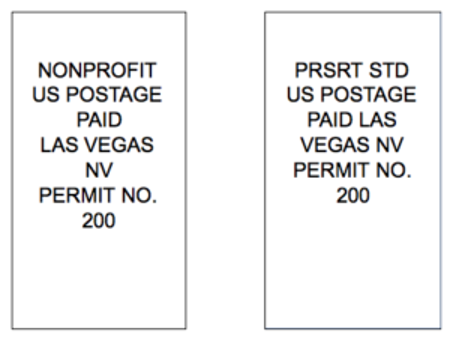
- The Indicia may be applied by printing press, lithography, mimeograph, multigraph or addressograph. They may not be hand drawn or typewritten. Contact the Mail Center (ext. 53786) for further information.
- The indicia must be applied in the upper right-hand corner on each piece, and each imprint must be legible, facing right side up, and be located on the front side of the piece. No information other than indicia may appear on the upper right-hand corner of the piece.
- All paperwork for Bulk mailings must be processed by the Mail Center. Please allow up to one to two working days for processing these types of mailings.
- Money can be saved by using the university’s non-profit mailing permit, however, you must be mailing mail that can qualify in Las Vegas as a non-profit organization and is sponsored by the university. The university can lose its non-profit permit if mailings are incorrectly mailed as non-profit. A mailing with a co-sponsor that is a profit-making organization cannot be sent out at the non-profit rates.
- Standard mailings are Bulk mailings that are not sponsored by the university or contain advertisements for another entity.
- The Mail Center retains a U.S. Postal Service Mailing Permit and is the primary Bulk Mailing Service provider for the university.
- University departments enjoy the service, expertise and economic benefit of directing nonprofit bulk mailings through the Mail Center.
- All inquiries pertaining to the use of the permit should be directed to the Mail Center.
- Third party mail houses are available. UNLV permit rates and services are not applicable when these services are utilized.
- Must bear the university’s address on each piece, or the mailing will be rejected by the U.S. Postal Service. Must identify the material as university-related or bear the UNLV address, and must be UNLV-sponsored.
- The return address must be the university’s and should read:
UNIVERSITY OF NEVADA, LAS VEGAS
DEPARTMENT NAME
Box45XXXX
4505 S MARYLAND PARKWAY
LAS VEGAS NV.89154-XXXX (Zip + 4) - An area of at least 1/2 the size of the piece should be left clear for addressing/labeling and should be no less than 3 inches x 4 inches. There may be no abbreviations in the city name, or Zip + 4. All envelopes must have the flaps sealed or tucked in.
- A folded self-mailer must be prepared with the folded edge at the bottom and parallel to the longest dimension and the address of the mail piece. The recommended minimum basis weight paper for folded self-mailers varies with the construction of the mail piece.
- Single folded sheet, sealed with one tab or wafer seal, minimum basis weight: 28 pounds (17 by 22 inches by 500 sheets) or 70 pounds (25 by 38 inches by 500 sheets).
- Two or more sheets, sealed with one tab or wafer seal, minimum basis weight: 24 pounds (17 by 22 inches by 500 sheets) or 60 pounds (25 by 38 inches by 500 sheets).
- With two tabs or wafer seals: minimum basis weight 20 pounds (17 by 22 inches by 500 sheets) if folded edge is at top or bottom of the mail piece. Tabs or wafer seals must be placed within 1 inch of the right and left edges of mail piece (see reverse).
- With folded edge on right (leading) edge: left (trailing) edge and other open edges must be secured with at least one tab or a glue line; additional tabs may be required based on trim size and basis weight.
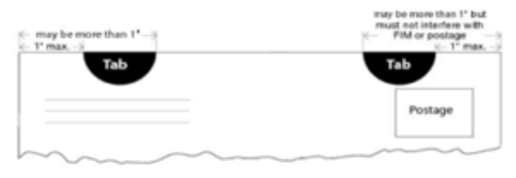
Campus Distribution
- If you have a university sponsored handout or flyer to be distributed campus wide, fill out the printing order to instruct the Mail Center who should receive it. We can send it to teaching faculty, professional staff, classified staff. We also deliver to department heads and to each mail stop for posting.
- When the handout is delivered to the Mail Center, we will put the proper amount of copies in each box to accommodate the requested distribution. It is then up to the department to distribute it at their mail stop.
- If your distribution has individual names and departments on them, we require that they be in box code order for distribution.
- When a department has a large campus distribution, it is required that the department put the mailing in order by department box code.
- For a campus sponsored distribution for an outside organization, there are guidelines to be followed.
- There is a cost per piece.
- The same guidelines apply as labeling inter-campus mail.
- The requirements for non-university related material is:
- Must have prior contact with a university department.
- Mail Center must be notified by that department of their involvement.
- There must be a department disclaimer or statement of their involvement printed on the flyer.
- Must in some way benefit university employees.
USPS Special Services
- Used for gifts and general merchandise, parcel post shipments may also contain books and other printed matter weighing 70 pounds or less.
- The maximum size is 130 inches in combined length and distance around the thickest part.
- Parcel Post is printed matter, merchandise, or other mailable material that weighs more than 13 ounces and not exceeding 70 pounds. Parcel Post must measure 108 inches or less in combined length and girth. The following is considered Parcel Post Matter:
- Circulars
- Catalogs
- Booklets
- Newsletters
- Merchandise
- Product Samples
- Photographs
- Printed Matter
- Money–back guaranteed (restrictions may apply) overnight to 2-day services includes tracking, proof of delivery, and insurance up to $100. (Additional insurance, up to $5,000, may be purchased for merchandise.)
- All packages must use a USPS produced Express Mail mailing label.
- The maximum weight is 70 pounds.
- Express mail international is a reliable high-speed mail service to over 190 countries (restrictions may apply), encompassing 3-5 average business day delivery to major destinations, free tracking, and up to $100 insurance (with additional insurance available for a fee). Limits of service vary by country destination.
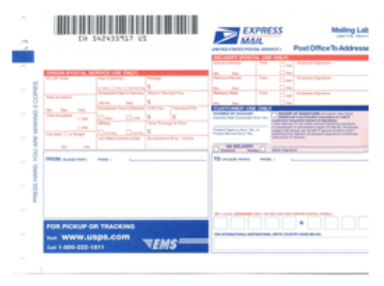
- Media mail is used in sending books (at least 18 pages, permanently bound) and educational materials including manuscripts, catalogs, films, printed sheet music, educational reference charts, computer readable media, specimens, and objective test materials.
- Media mail can weigh less than 13 ounces. The maximum size of an item in combined length plus girth is 108 inches.
- This rate is less expensive than First Class/Priority, and each piece should be marked “Media Mail.”
- Insurance provides coverage against loss or damage up to $5,000 for Priority Mail Express, Priority Mail, First-Class Mail, Parcel Select, Library Mail and Media Mail. Items may not be insured for more than their value.
- Priority Mail Express provides $100 of insurance coverage and Priority Mail provides $50 of insurance.
- Postal insurance (up to $600) may be purchased domestically.
- The USPS will not reimburse mailers in amounts higher than proven value. Don’t over-insure packages.
- Insurance limits vary from country to country.
- Fragile items must be packaged with cushioning materials; heavy or bulky parcels must be reinforced with filament tape. Packages that appear to have been insufficiently prepared will not be accepted for mailing.
- A return receipt may be requested to show written evidence of delivery. International Postal insurance is available to some countries for parcel select only.
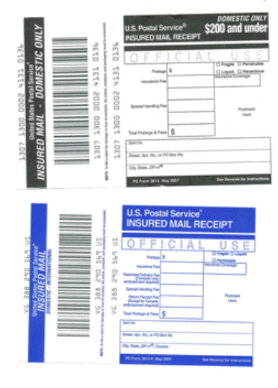
- Certified Mail provides proof of mailing at the time of mailing and date and time of delivery or attempted delivery. A delivery record is maintained by the USPS.
- Certified Mail is available with first class mail and priority mail. For an additional fee, Certified Mail may be combined with restricted delivery or return receipt.
- Certified Mail is a DOMESTIC service only.
- It provides a record of mailing for the sender, but does not provide any indemnity coverage. The record of delivery is kept at the destination post office.
- Certified mail must be sent First-Class. A return receipt may be requested to show written evidence of delivery.

- A return receipt provides the sender a postcard or electronic notification via fax or email, with the date of delivery and recipient’s signature.
- Return Receipts may be obtained for Priority Express, (by mail only) First-Class Mail, Priority Mail, Parcel Select, or Media Mail when purchased with one of the following; Certified Mail, COD, insured for more than $200, and Registered Mail.
- Return receipts (cards) are available from the Mail Center.
- Return receipts must be filled out completely. Be sure to include your UNLV mail code in the return address.
- Note: The fee for a Return Receipt does not insure the article against loss or damage.

- Registered Mail provides maximum protection and security for valuables.
- It provides the sender with a mailing receipt and delivery record is maintained by the USPS.
- Registered Mail is available for items paid at priority mail and first-class mail prices. It may be combined with COD, Delivery confirmation restricted delivery, return receipt, or signature confirmation.
- Postal insurance is provided for articles with a declared value up to a maximum of $25,000.
- Registered mail is the most secure method of sending valuables through the mail system. It provides the sender with written evidence of mailing.
- This service is offered for both domestic and international mail.
- Costs include a registry fee in addition to postage. A value must be declared for the mail at the time of mailing. The registry fee for domestic mail will be determined by the declared value. The maximum declared value for international mail is low; nevertheless, it remains the most secure, (not speedy) method for sending international mail.
- Domestic registered mail must be processed at the First-Class postage rate.
- Several service levels are available for international Registered mail. A return receipt for registered articles may be requested to show written evidence of delivery.
- An envelope or parcel prepared for Registered mail must be sealed so that any unauthorized opening will break the seal. Parcels must be sealed with plain paper or cloth tape on all seams of the article. If a parcel is heavy or bulky, reinforce it with strapping tape before wrapping and sealing. Padded envelopes are not accepted for domestic registered mail. Envelopes or parcels improperly or insufficiently prepared will not be accepted for mailing. Tape used on registered articles must be able to absorb a postmark. Slick plastic tapes are not acceptable.
- International mail rates, classifications, special services, weight and size limits, and other mailing requirements differ from those of domestic mail. International mail offers First-Class and Priority
- International mail packages weighing 13 ounces or more require custom forms. Therefore, please provide contents and commercial value so the proper forms can be completed. The forms can be obtained from the Mail Center and completed prior to being forwarded to USPS.

- Mail addressed to a foreign country should include the country name printed in ENGLISH AND IN CAPITAL LETTERS (no abbreviations) as the only information on the bottom line should be the country:
MR THOMAS CLARK
117 RUSSEL DRIVE
LONDON WIP6HQ
ENGLAND - All international letter mail must be enclosed in an envelope or package of durable material.
Pick your country and follow instructions for accessing mail information. This site is maintained by the Universal Postal Union and outlines the elements that form the basis for proper postal addressing in each of the 189 UPU member countries, including the structure of its postal code(s).
- Mail of any kind for transport by the U.S. Postal Service should be enclosed in an appropriate envelope or parcel and sealed. The types of enclosures determine the mailing classification.
- The following are samples of non-mailables in envelopes.
- Paper Clips
- Metal Pieces
- Glass Chips
- Sand
- In addition to jamming and/or damaging the mailing machines, these items can also cause serious injury to Mail Center employees.
- All foreign countries also impose various restrictions depending on country and item(s) being mailed. It is recommended that when mailing questionable items to U.S. or foreign destinations, the mailer should contact the Mail Center for assistance.